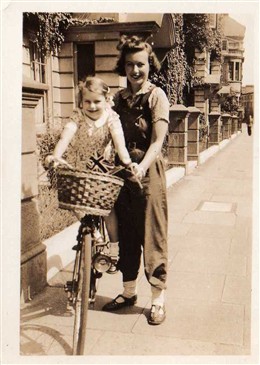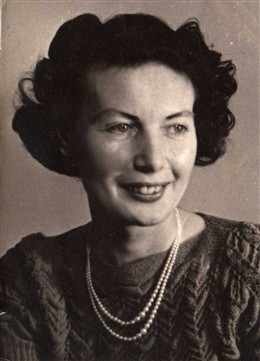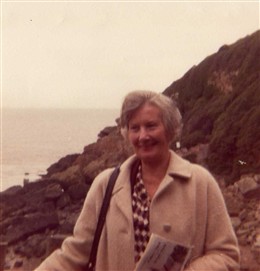A Backward Glance

Patricia Richards with daughter Geraldine
Geraldine Paine

Patricia Richards
Geraldine Paine

Patricia Richards
Geraldine Paine
I knew nothing about nursing, Morse Code, or any of the things more efficient women were rushing to do
By Patricia Richards
When war broke out on 3 September 1939, I found I was very ill-equipped to take part in something that threatened to engulf us all. I knew nothing about nursing, Morse Code, or any of the things other and more efficient women were rushing to do, but I could drive a car, and this one asset took me to a large ambulance station in Knightsbridge, which was being hurriedly organised into a working unit.
I was interviewed by a tall, beautiful, red-haired woman in a blue uniform, who, after telling me in a friendly way I was about to join the Death Brigade, enrolled me as an ambulance driver.
My fellow drivers were a mixed collection of men and women. The women drivers came, mostly, from wealthy houses in Kensington and Sloane Street, all were volunteers and nearly all were very young, in fact, our red-haired commandant was only a few years older than any of us.
Later in the war she met and married the Marshal of the Royal Air Force, Lord Tedder, but that is another story. One day I shall tell it, all that led up to it, and the aftermath of sadness and tragedy.
The men drivers, with one or two exceptions, were peace-time chauffeurs to the rich dowagers of Sloane Square, Mayfair and Kensington, who loaned them and their limousines to the ambulance service for the duration of the war. It was a marvellous and most generous gift in times of great need, given at considerable cost to themselves.
We had good reason to be grateful in the dark months to come for these efficient and gentle men. Their humour and courage during the worst moments of many air-raids soothed our feelings of fear and made what were doing seem bearable and sensible.
We were stationed at Kingston House, with our ambulances, cars, stretchers and all the paraphernalia of war-time service, and here we were to work happily, if dangerously, for the next five years.
We learnt First Aid from the regular peacetime ambulance men, and struggled at first in theory. But soon, in practice with bandages, splints and tourniquets, we learnt to lift men, women and children of all sizes from every impossible position ever devised by man and the falling bomb. We learnt the shortest routes to hospitals, first-aid posts and mortuaries. We learnt every street in the Westminster area, every cul-de-sac, every short cut; we learnt to drive and see in the dark, and to be thankful we were alive and safe every morning. And, mercifully, we learnt to shut our minds to the horrors we saw around us: a baby lying trapped up under a girder, a head in the gutter, people without arms or legs, a fire, a broken main flooding a crowded air-raid shelter, and people dying amongst dust and dirt and broken glass.
The outside world changed almost as much as we did during these years. The lovely long roads of Knightsbridge and Kensington, Emperor's Gate and Queen’s Gate, lay empty and defenceless under the sky. Buses were few and far between, often forced to give up the unequal struggle against sirens, bombs, craters in the road, and non-arrival of bombed-out crews. Hyde Park became a graveyard for the bombed houses of Kensington. Hundreds of baths and basins, gilded gates and stone statues lay in lanes between the avenues of trees. Tall, lovely houses were boarded up and empty, glass lying deep in neglected gardens. Other houses, not so lucky, lay where they had been hit, their elegance and strength a heap of broken stone and blackened wood, and everywhere, carried on the wind, the faint smell of burning, that unmistakable, never to be forgotten, smell of war-time London.
Dogfights in the sky were an almost daily occurrence in the early days. We would watch the twisting planes, so high in the blue sky, like small insects, the sunlight catching their wings as they dipped and fluttered around each other, and in the silence we could hear their guns firing.
Everyone rode bikes. We soon found this was the quickest and best way of getting anywhere. A trousered, tin-hated woman pedalling furiously during an air raid became a familiar and friendly sight and no longer the object of derision.
Values changed. No one cared any more if one owned a house, a car or a fur coat. It became unpatriotic to make a lot of money or even to possess very much, and to be well dressed was suspected of coupon-fiddling and the Black Market.
There was everywhere a feeling of warmth and respect for each other, not always felt in peace-time, and although we knew that in the end only the strong would survive, the weak were helped, not pushed out of the way. Life which was so precarious became somehow so much easier to live.
These were sad times sometimes, tragic times often, but good or bad they were stirring times, and those of us who lived and survived through them were moulded by what we saw and did, for better or worse, into what we are today.